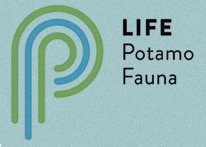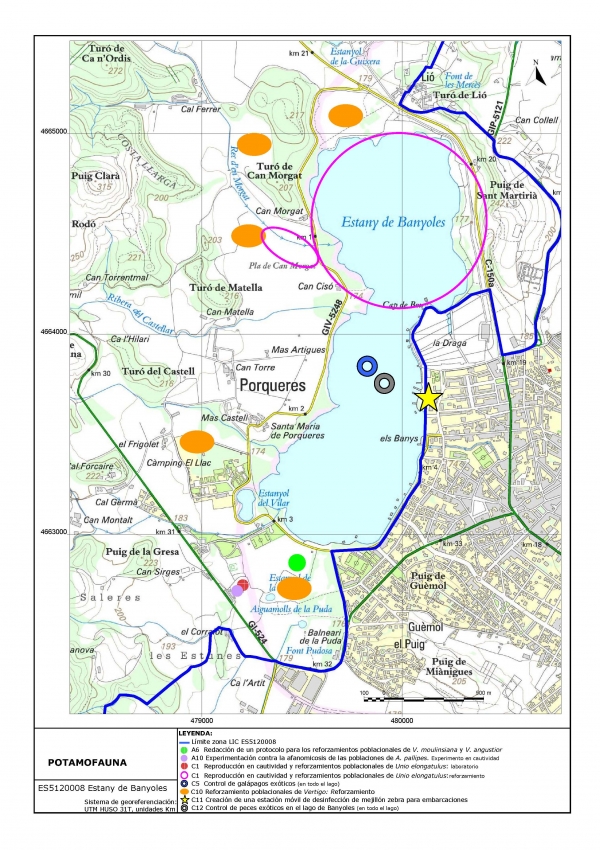Banyoles Lake
Surface: 1,064.000 hectares
The Natura 2000 Banyoles Lake (ES5120008) is part of the Ramsar List of Wetlands of International Importance. BanyolesLake is also classified as Area of Natural Interest included in the Plan of Natural Interest of the Government of Catalonia. Part of the southern shores of the lake have been declared as a Historic Garden of National Interest by the Government of Catalonia.
The BanyolesLake basin is located in the northeast of the Iberian Peninsula and is the point of a lower upwelling hydrogeological system, largest-called Banyoles and Garrotxa, and also includes the lagoon of Espolla. The origin of the water is in the region of Alta Garrotxa 25 kilometers to the north, where the rain water enters a limestone outcrop surface of 900 meters, causing a huge confined aquifer. This aquifer flows south to meet with waterproof materials due to a fault, near Banyoles, at 174 meters altitude with above the sea level.
The working area of the project does not include the entire space LIC. Here the project area focusing solely on water bodies, particularly Banyoles Lake and other lakes, ponds and ditches around them, where aquatic species objective of the project occur.
The importance of this space is highlighted by the presence of up to 11 habitats of Community interest (Annex I of Directive 92/43 / EC). Hydrophilic vegetation dominated by reeds (Typho-Schoenoplectetum glauca) and peaty reeds dominated by saw-sedge (Soncho maritimi-Cladietum Seafood [7210 *]) forming a belt around the perimeter with plant communities submerged vegetation water oligomesotrophic Chara spp. [3140] and rooted vegetation or floating hydrophytes lakes and eutrophic, Potamion [3150]. In the flood plains around the lagoons and lakes are herbaceous communities Magnocaricion elatae composed by large sedges, and in moist soils but emerged we can find Mediterranean meadows of tall grass Molinio-Holoschoenion [6420].
The undeveloped part of the lake has a reclaimed area of alluvial forests with Alnus glutinosa and Fraxinus excelsior and the community of Alno-Padion, Alnion incanae or Salicion albae [91E0 *] and gallery forests of Salix alba and Populus alba [92A0]. In the streams that carry water or drain the lake, whether permanent or intermittent flow, these communities have Paspalo-Agrostidion with riparian plant like Salix sp. and Populus alba [3280].
Regarding the species, up to 15 species included in Annexes II, IV or V of this Directive exists in the area. Of these, pond turtles (Emys orbicularis and Mauremys leprosa), barbel (Barbus meridionalis) and the naiad (Unio elongatulus) are direct objective of this project, while others will benefit indirectly. In relation to the naiads is remarkable its richness and uniqueness in the lake, which are at least four native species. This situation is not repeated in any other body of water in the region, nor probably in Spain.
The importance of the populations of BanyolesLake species objective of this project is remarkable, although difficult to quantify in terms of demography.
the Naiad Unio elongatulus. Its regression in catalan basins has been dramatic. The population of this species existing in Lake Banyoles is one of the few spots (<10) that are known in the basin of the River Ter and the whole basin of northeastern Catalonia. Apparently, despite being seriously threatened and in obvious decline, the population is also one of the best populations in the basin. In this context, a previous LIFE Improvement of Habitats and Species Natura 2000 in Banyoles (LIFE08 NAT / E / 000078) in the period 2010-2013 have been implemented actions for the recovery of this species. On the other hand actions were performed to restore native fish populations. It has developed a protocol breeding facility and laboratory facilities for breeding naiads, which are obtaining hundreds of individuals 1 and 2 years old to repopulate the lake. These results enable the Consorci de l’Estany to produce several hundred Unio elongatulus from parental resettlement areas to repopulate other river basins of the rivers Muga, Ter and Fluvià. Thus the experience of BanyolesLake may allow the recovery of the species in the other fluvial environments of the project.
We emphasize that in the area Anodonta woodiana, Corbicula fluminea and Dreissena polymorpha species, have not yet been identified, which are other bivalve invaders that have been detected in bodies of water basins of the rivers Ter and Fluvia, or Catalonia. The threat of these species in the wetlands of Catalonia is very high, even in stagnant water bodies such as lakes and marshes. It is vitally necessary to establish preventive measures to prevent the introduction of these species, especially zebra mussels in BanyolesLake controlling activities such as fishing and the entry and movement of boats on the lake.
Mediterranean Barbel (Barbus meridionalis). This species is experiencing a gradual decline in the whole distribution area in he world, located in southern Europe. While still maintaining stable populations in dense areas, in some rivers has disappeared from many sectors, especially along the main river axes previously occupied. Also notable is the fact, that has little or nothing in common throughout the distribution area, of the character of the lakeside town of Banyoles, where it appears that the usual observation of large specimens is quite common. In the basin of the River Ter, Barbus meridionalis has still stable populations in some areas, though, is in decline globally, having disappeared completely from the lower course of the river and almost completely of most courses tributaries flowing into this sector including TerriRiver, which receives the waters of BanyolesLake.
In this context, a previous LIFE Improvement of Habitats and Species Natura 2000 Banyoles (LIFE08 NAT/E/000078) have executed actions for the recovery of this species. Efforts have been directed to control populations of exotic fish from the lake, and have also been stocking the river with specimens from Terri. The recovery of this population in BanyolesLake ensures its long-term conservation in the basin, as well as a gradual colonization of river sections located downstream.
Pond turtles (Emys orbicularis and Mauremys leprosus). These species have experienced a significant decline in Spain and throughout Europe. In Catalonia, this decline has been particularly sharp, having almost completely disappeared from most of their respective occupation zones original. Until 2010, Banyoles could occur almost extinct species because only two had evidence of the presence of a few isolated specimens of large size and had not seen any evidence of reproduction. In the case of Mauremys leprosa there is spontaneous recovery. Worse is the situation of Emys orbicularis in the whole of Catalonia, where there are currently only five populations, two of them in critical condition, including Banyoles. In fact, the most optimistic estimates suggest that there are fewer than 1,000 individuals in the wild throughout Catalonia. Thus, the recovery of these two turtles in Banyoles, where have suitable habitat, it is of considerable importance and priority for long-term conservation Catalan scale.
In this context, a previous LIFE Improvement of Habitats and Species Natura 2000 Banyoles (LIFE08 NAT/E/000078) have executed actions for the recovery of this species. They have released more than 100 specimens of Emys orbicularis in different wetlands around LakeBanyoles. The adaptation of the units has been very good and is expected to play in a few years to ensure the establishment of a core player in the area. At the same time it is necessary to make catches by exotic species of turtle trapping.
Narrow-mouthed Wnorl Snail (Vertigo angustior and Vertigo moulinsiana). These species in the Iberian Peninsula have been mentioned a few populations over the last century, all situated in the provinces of Barcelona and Girona, always living on the margins of ponds and marshy areas permanently wet. They require that the water level of the lakes where live plants do not suffer considerable ranges, thus not living in the margins of reservoirs, or lagoons subject to changes in water level. The population of Vertigo moulinsiana preserved in Lake Banyoles is widespread in the lake area appearing in all sampling stations where the marsh vegetation is well preserved. Despite the presence of Vertigo angustior is scarce, appearing in only two sampling points, highlighting the abundant density in the karstic and permanent lagoon called Estanyol de la Cendra. The data obtained from sampling conducted in 2010 by the staff of the Laboratory of Zoology of the University of the Basque Country and included in the program of action of the Consorci de l’Estany, consider the system of Banyoles Lake is one of the best locations, or even the best, in the Iberian Peninsula for the conservation of Vertigo angustior and Vertigo moulinsiana, two species of Community interest (Red Book of the invertebrates of Spain).
Back to list of areas for action

















